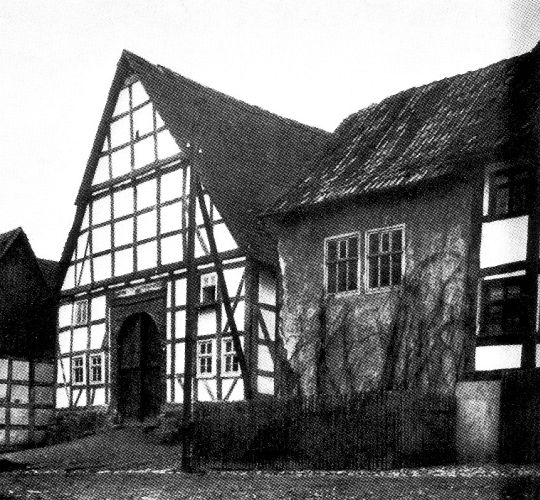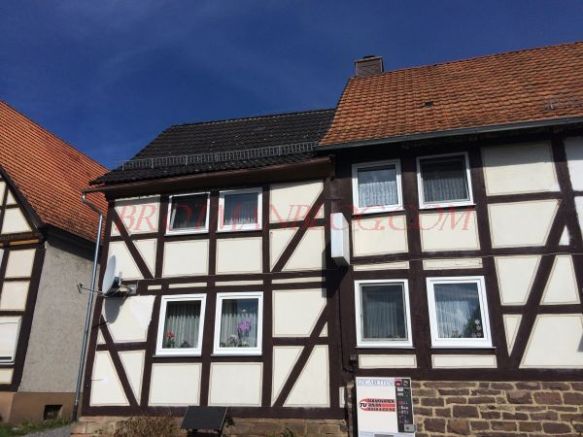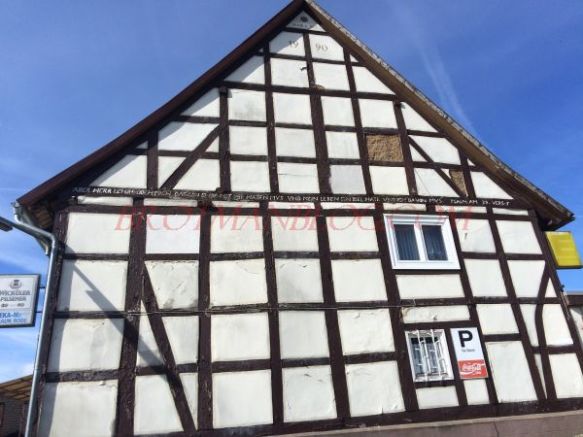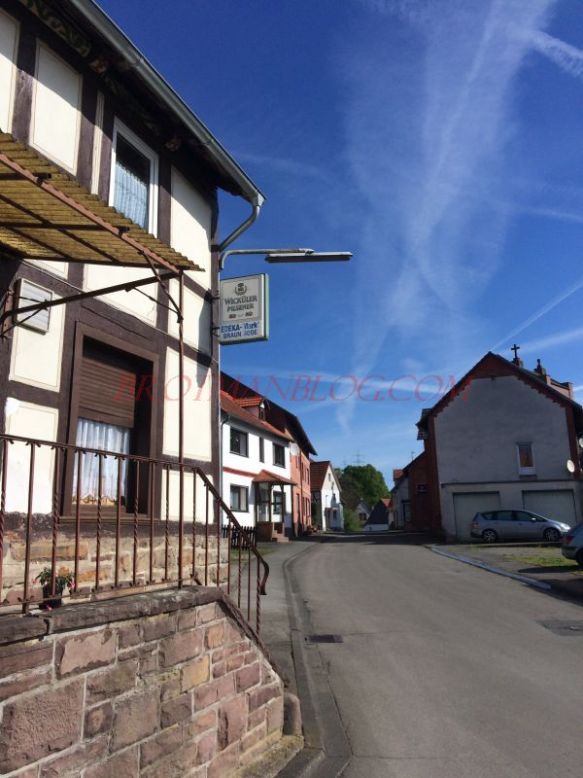After spending the prior day in Volksmarsen and Breuna, home of the Hambergs, I was excited to go to Sielen, the home of the Schoenthals. We were going to meet two people in Sielen, Julia Drinnenberg, with whom I’d only exchanged a few emails, and Hans-Peter Klein, with whom I’d been in touch for a couple of years. Hans-Peter and Ernst (not related to each other) created the Juden in Nordhessen website that has provided me with extensive information about my Hessen ancestors. When I was researching the Schoenthals, Hans-Peter was a tremendous help. He also knew my friend from home, Amanda, so I was looking forward to meeting him and Julia.
Sielen is about forty minutes from Kassel, the city where we were staying, and the drive was quite scenic. We went over the mountain (hill?) where the Kassel fortress is, then along a winding and narrow road, and then through beautiful countryside. As we approached Sielen, there was a flock of sheep grazing in the field on the edge of the village. I decided to get out and take some photographs of the surrounding area.
As I was doing that, another car pulled up alongside me, and a man got out and asked me if I was Amy. It was Hans-Peter, and we both laughed at the fact that he knew it had to be me, given how small and isolated Sielen is. We both drove into the village where Julia soon appeared as well. She was also outgoing and friendly, and we all hit it off right away.
As in the other towns and villages, there was a marketplace and a church. But Sielen is much smaller. Whereas Gau-Algesheim has a population of about 7000, Volksmarsen about the same, and Breuna almost 4000, Sielen’s population is only about 500 people. It was the smallest village we visited.
While we were all getting acquainted, a man appeared in the marketplace where we had parked, yelling in German. Harvey and I were both a bit intimidated, but after some discussion with Hans-Peter and Julia, the man left. Apparently we had driven up to the marketplace the wrong way.
Julia had some historical information about Sielen to share with us. According to a 1789 report on Sielen by J. Chr. Martin entitled “Topographical and Statistical News of Nether Hessen, Goettingen (1789, p. 103, as translated), at that time there were 114 homes in Sielen and about 500 residents: “106 men, 112 women, 128 sons and 123 daughters, 14 servants, 14 maidens.” In terms of livelihoods, the report noted that there were forty farmers, 76 peasants, seventeen “cloth-weathers,” one blacksmith, one wainwright, one tailor, and two carpenters. The report adds, “Also there are two Jewish families who make their living by trading.” I had to wonder whether my Schoenthal ancestors were one of those two families. Levi Schoenthal, my great-great-grandfather, was born there in 1812, so perhaps his father Heinemann was already living there by 1789.
As I wrote previously, according to the Alemannia-Judaica website, there was a very small Jewish community in Sielen at least from the early 19th century. There was a synagogue in Sielen as early as 1817, and the village had its own Jewish cemetery starting in 1846. In 1835, there were 38 Jewish residents; in 1861, there were 48. By 1905, there were only fourteen Jewish residents, and by 1924, there were just four Jewish residents remaining. My Schoenthal ancestors had left Sielen by the 1880s.
Julia’s papers also included a later report about Sielen, written in 1932-1934, around the time that Hitler came to power. This document, written by Superintendent I.R. Brandt and titled “Chronicle of Sielen,” provides some insight into the status of Jews at that time. It can be found at the Landeskirchliches Archiv Kassel, D 2.2 Hofgeismar v.O. HS 22. There were two Jewish families left, one being an elderly woman named Perle Herzstein, whose house was attached to the old synagogue.

Sielen synagogue (center building)
http://www.alemannia-judaica.de/images/Images%20148/Sielen%20Synagoge%20111.jpg
The report goes on (p. 109)(as translated in the document Julia gave me):
Inside it is desolate, there aren’t any church services for a long time. But the old keeper of bygone splendor [Ms. Herzstein] shows us proudly the marvelous tora-rolls, man-high and from thick parchment, lovely as on its first day. And she shows us the colorful embroidered silk ribbons twined around them, and other books and things. She sighs in remembrance of former, for her, better times!
The next few lines are confusing—I am not sure whether it’s the translation or it was as confusing in the original:
Yes, it’s true, the Jew misbehaved in Hesse in former times. He often contributed to his own pauperization by profiteering and Gueterschlaechterei, etc. (?) Nowhere else the antisemitism of National Socialism is carrying greater justification than in Hesse. But these ordinary harmless people scattered here and there in small villages for many a long year, who still belong to orthodox Judaism and whose integrity and strength of character…cannot be denied—they just belong to the colorful German nationhood. It would leave a void if it were weeded out completely.
It seems that, on the one hand, the writer is condoning anti-Semitism, but on the other is praising the Jewish residents of the area and admitting that it would be a loss for the community if they were “weeded out completely.” I wish I knew more about this source; perhaps Julia can give me more information about it.
At any rate, today there are no Jews in Sielen. Julia told us that the house depicted below was where the last Jew in Sielen lived until the 1930s when at some point he was dragged from the house and beaten.
When I asked Julia and Hans-Peter what people did for a living today in these little villages, they said many are employed in Kassel (there is a Volkswagen plant near Kassel) while some are tradespeople. Not many are farmers any more.
We walked to where the synagogue once was and stood outside what is now a large home. We walked around the corner, looking for some indication of where the entrance had been, and as we stood outside, a man came out.
After our experience with the angry man in the marketplace, I was concerned that this man also was going to yell at us for loitering in front of his house. But instead he asked what we were doing, and when Hans-Peter and Julia explained, he became very interested, asking more questions. He introduced himself to us (his name, Braun Rode, was on the beer sign outside the house—perhaps it is also a tavern). He and his wife had lived in the house for 40 years. And he was very happy that we had come to see it.
Then his wife came out and offered us all something to drink. When we all declined, she returned with a book about the former synagogues in Germany and showed us the picture of their house when it had been the synagogue (see above).
These two people, who did not know us at all, could not have been nicer. Herr Braun Rode insisted that we take photographs with him in front of the house and send him a copy (which Julia did). When we said goodbye, he said to us in German to send regards to America. Once again, we were left with a very positive and warm feeling about the people in Germany.

Julia Drinnenberg, Hans-Peter Klein, Herr Braun Rode, and Harvey outside the former synagogue in Sielen
We then drove to the cemetery that lies outside the village up a rather steep hill. It is hard to imagine how people from Sielen and the other nearby villages managed to get the bodies of the deceased to these cemeteries.
There were not a lot of stones in the cemetery, and I looked at each one several times, hoping to find my great-great-grandfather Levi Schoenthal, or any other Schoenthal, but I had no luck. Some of the stones are completely eroded, and others are only in Hebrew and were extremely difficult to read. Julia had a transcription of the stones, and there was this one, which I had previously found in my research:
Thanks to the helpful people in the Tracing the Tribe Facebook group, I know that that translates as “Chaim Schoenthal from Sielen died 7 Nissan 5634,” or March 25, 1874, which is four days before the date I had for Levi’s funeral (the actual date of death was not legible in the death record).
The name as transcribed confused me since it was not Levi, but Chaim was probably his father Heinemann’s Hebrew name, so I think the transcriber could not read Levi’s own first name and transcribed only the patronym. It probably said “Levi ben Chaim Schoenthal.”
But even with that transcription, we could not find the actual stone. The transcriptions were done over 30 years ago, so the stone must have badly eroded since then. I examined each stone, hoping to find an inscription that contained the name of my great-great-grandfather. But it was not to be.

Sielen cemetery. I now think that the very eroded sign on the left could have been where Levi Schoenthal was buried.
Although I was disappointed not to find the stone for my great-great-grandfather, it had been a great morning, meeting not only Hans-Peter and Julia, but also the friendly couple who live in the house which was once the synagogue. Sielen is a tiny jewel with a long history, and it might have been a good and comfortable place to be a child growing up. But now I better understand why my great-grandfather Isidore Schoenthal and all his siblings left the village. There was not much there to support a young adult who wanted to go out on his or her own.
UPDATE: On December 2, 2022, Julia sent me photographs of Levi’s headstone and an updated transcription of the inscription on the stone. I was correct—the original transcription was not complete and the name “Chaim” was a reference to Levi’s father Heinemann, not to Levi himself. Here are the photographs and the updated transcription in Hebrew and in English.
פ”נ
איש הישר ר אריה בר ר
חיים שענטהאל מזיעלן
הלך לעולמו יום ז’ ניסן תרל”ח
Here rests
an honorable man R. Arieh son of
Haim Schönthal from Sielen
he came in his world on 7. Nissan 5638
As Julia pointed out, Arieh means lion in Hebrew and thus may have been the Hebrew equivalent to Leon or Leo and paired with Levi as his full name.
Thanks again to Julia for finding the stone and providing me with a better transcription of its inscription.























amy what great reading and wonderfu photos
LikeLiked by 1 person
Thanks—what with the “hotosh?” 🙂
LikeLike
Amy, these photos are so clear, I feel like I’m looking at the scenes from inside my own house rather than from the laptop screen! I found the excerpt from “Chronicle of Sielen” very unsettling. This is just my response for which I make no hesitation. It is as if the writer is trying to rationalize his way through a situation that is not acceptable and which he knows isn’t acceptable but has no power to stop.
LikeLiked by 2 people
I agree—the writer seems at best ambivalent if not a bit guilty about what he is writing. And thanks! I used my iPhone 5s—so I am really glad they came out well.
LikeLiked by 1 person
I am impressed.
LikeLiked by 1 person
Amy, I had some trouble with my laptop freezing. I don’t know if the comment got through. First, the photos are crystal clear. I feel as if I’m looking at the scene from the windows of my home instead of seeing them on the laptop. Second, I found the excerpt from “Chronicle of Sielen” very unsettling. It is as if the writer is trying to rationalize a situation he knows is very wrong and he also knows it’s much bigger than he can influence or solve.
LikeLiked by 1 person
It did. See my response above. 🙂
LikeLiked by 1 person
The images you’ve displayed are good enough to picture postcards, Amy. Great job!
LikeLiked by 1 person
Thank you—all from an iPhone 5s!
LikeLiked by 1 person
Amy, It looks like the cemetery has been cared for and not overgrown. You have really walked in the steps of your ancestors. The “Chronicle of Sielen” is very upsetting. Great research took you to this small village!
LikeLiked by 1 person
Thanks, Maryann! Yes, the cemetery is well-cared for. Unfortunately, stones erode over time no matter what humans try to do.
LikeLike
Pingback: Friday finds: Week 24 – 2017 | Norwegian Genealogy and then some
Amy, this is awesome and I am jealous. I hope to get back to Germany to look for my Kempker, Menke, Merschmann and Brandevinder lines.
LikeLiked by 1 person
I hope you get there also. It is such a moving experience.
LikeLike
Parts of this post made me feel very sad, but i am so happy for you that those “strangers” were so nice to you!
LikeLiked by 1 person
There were many bittersweet parts of this trip, but overall it was a happy one—mostly because of the people we met.
LikeLiked by 1 person
Those are usually the best (or worst haha) memories!
LikeLiked by 1 person
What a compelling read, Amy. I felt like I was on your journey with you. I feel your disappointment to have traveled so far and not find your second great-grandfather’s stone, but the people you met sound like they made the experience worthwhile.
LikeLiked by 1 person
Thank you, Michael. Oh, believe me, the experience was more than worthwhile! Although I didn’t find the stone, I know he was buried there, and I saw the village where my great-grandfather grew up. The stone would have been nice, but walking in the footsteps was the most important thing.
LikeLike
It took me a few days before I could get to this post, but as with all the rest, I am so enjoying my tour of your ancestral trail. I am just amazed that there is even a cemetery left and it was not destroyed….
LikeLiked by 1 person
Thanks, Sharon. I think one reason these cemeteries survived is that they are in the middle of nowhere. As is Jewish custom, most are way outside of the densely populated centers where people lived—even in the smaller towns and villages. The one in Sielen is a few miles from town and up a steep hill. I can’t imagine how they got the bodies to the cemetery.
LikeLiked by 1 person
Pingback: Another Mikveh, A Castle, A Museum, and A Search for Stones: Trendelburg, Hofgeismar, and Gudensburg | Brotmanblog: A Family Journey
How disappointing you couldn’t identify his stone. Time wears things down. But not, I think, a genealogist’s heart. Lovely post Amy.
LikeLiked by 1 person
Thanks, Amberly.
LikeLiked by 1 person
I must say, Amy, the placement of your photos in the post added to the suspense. Like Amberly, I was so hoping you would discover the stone. Thanks for sharing your impressions of the town and surrounding area.
LikeLiked by 1 person
Thank you, Cathy. In my heart I feel that even though I didn’t find his stone, I paid tribute by being there and trying.
LikeLiked by 1 person
I’m so behind in my reading 😦 Like others have said, I really feel like I’m taking this journey with you. I’m so happy you were able to make this journey and hope someday I will be able to do the same.
LikeLiked by 1 person
I do, too, Debi. And don’t worry about being behind. The nice thing about a blog is that the pages stay there. 🙂
LikeLike
My family had a cemetery in Sielen Kanter Family. Would be very interested if someone has information about it and would share it with me. Thanks Hermann Kanter hkbh@comcast.net
LikeLiked by 1 person
I will email you.
LikeLike